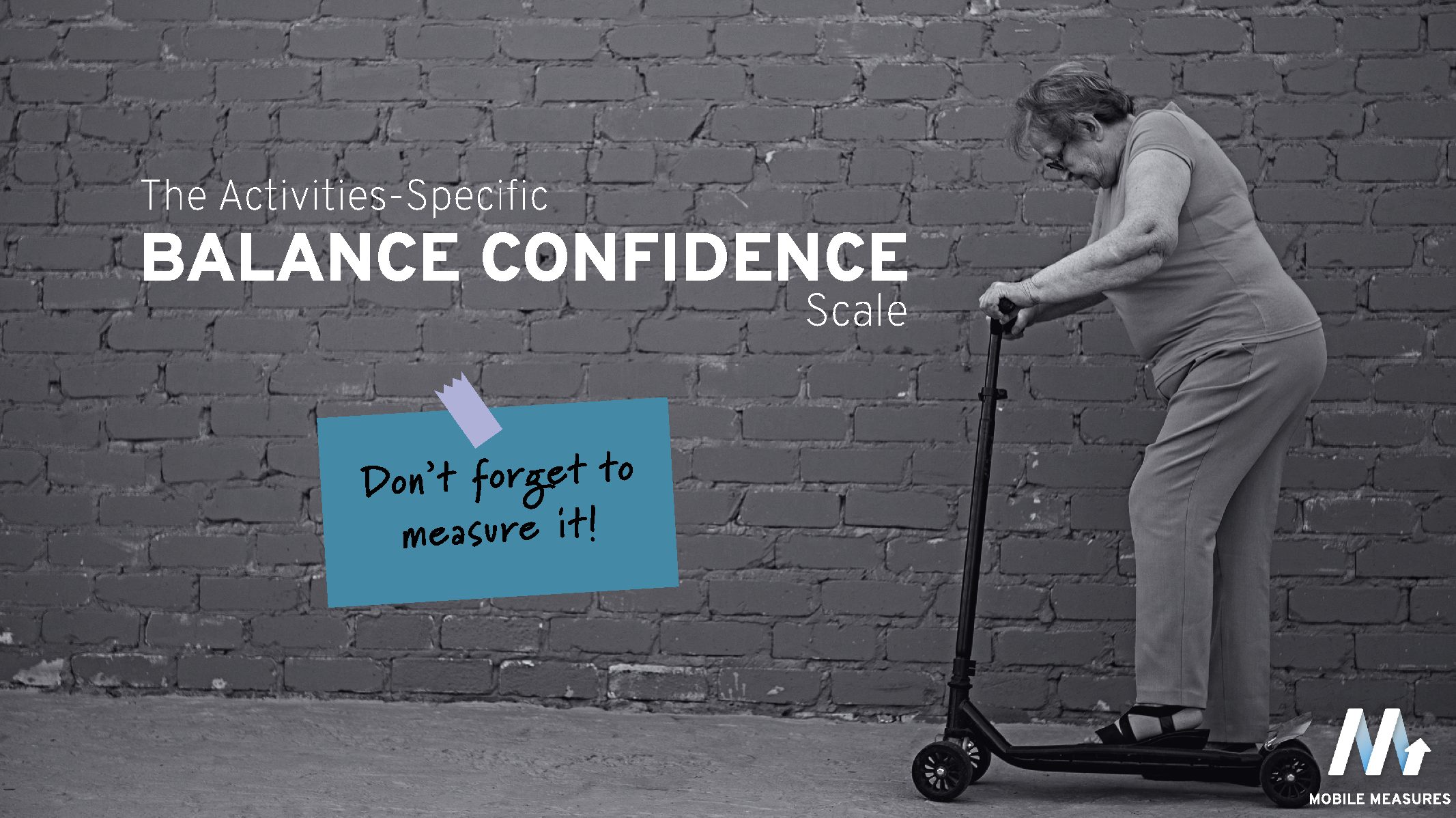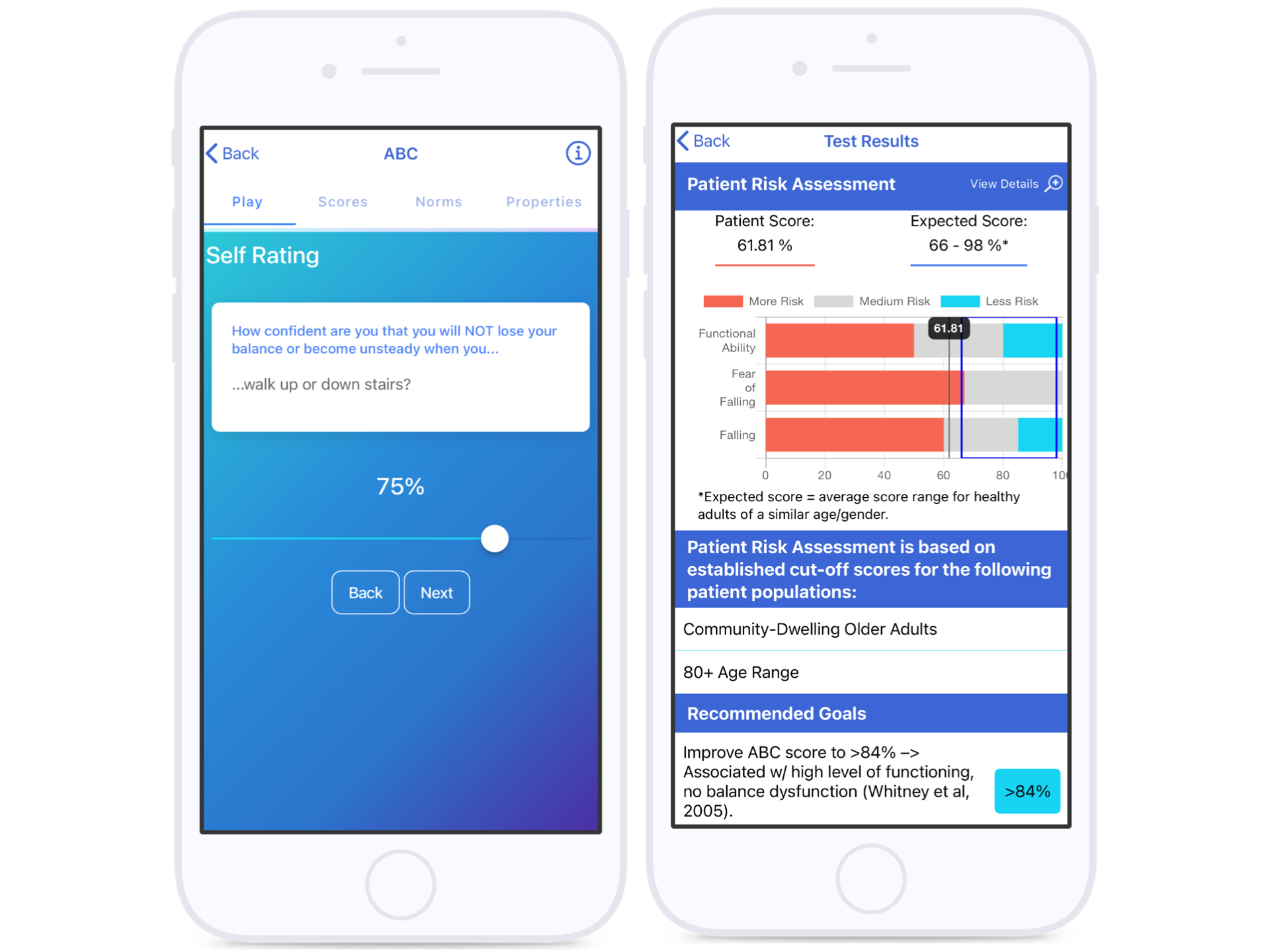Share on facebook
Share on twitter
Share on linkedin
Share on email
Assessing balance and fall risk is a key part of the physical therapy evaluation for older adults, especially in the home health and acute care settings. Many internal and external factors play a role in a person’s risk of falling. An important but often overlooked factor is balance confidence.
The Activities-Specific Balance Confidence (ABC) Scale provides a means of objectively measuring balance confidence and has been validated to assess community-dwelling older adults, individuals living with Multiple Sclerosis, Parkinson’s Disease, and more.
Why is it Important to Assess Balance Confidence?
Assessing an individuals balance confidence using the ABC Scale can provide valuable information about your patient’s true risk of falling, especially when combined with a functional assessment such as the Berg Balance Scale (BBS).
Someone who is overly confident but scores poorly on the BBS may be more likely to put themselves in situations beyond their actual capacity. This patient will require additional education to improve their insight into their functional abilities and/or require caregiver supervision to reduce risk of falling.
On the other hand, someone with low balance confidence will likely have a fear-of-falling and limit their activity, leading to further deconditioning and worsening mobility. It is unlikely that these patients will see significant improvements in mobility until their balance confidence is addressed.
The ABC Scale is particularly useful because it allows the clinician to identify up to 16 specific activities that your patient is having difficulty with or is afraid of attempting. If the activities are important to the patient, you can easily turn them into balance interventions.
What is the Activities-Specific Balance Confidence (ABC) Scale?
The Activities-Specific Balance Confidence (ABC) Scale is a patient-reported outcome measure that asks individuals to rate how confident they are that they will not lose their balance while performing 16 different activities.
The ABC Activities range from common tasks like walking around the house to less common and more challenging situations, like stepping off of a moving escalator while carrying packages.
How to Administer the Activities-Specific Balance Confidence Scale
The Activities-Specific Balance Confidence (ABC) Scale [Downloadable PDF]
The ABC Scale can be self-administered or administered via personal or telephone interview. Electronic versions of the ABC Scale are also available.
The patient is asked to rate their confidence in their balance, while performing 16 activities, on a percentage scale of 0 to 100, where 0 is a certainty of falling or becoming unstable and 100 is complete confidence in the patient’s own ability to stay balanced.
The 16 ABC activities are as follows:
How confident are you that you will NOT lose your balance or become unsteady when you…
- …walk around the house?
- …walk up or down a set of stairs?
- … bend over to pick up a slipper or other items from the floor of a closet floor?
- …reach for a small can off of a shelf at eye level?
- …stand on your tiptoes and reach for something that is above your head?
- …stand on a chair and reach for something?
- …sweep the floor?
- …walk outside of the house to a car that is parked in the driveway?
- …get into or out of a car?
- …walk across the parking lot to the mall or stores?
- …walk up or down a ramp?
- …walk in a crowded mall where people are rapidly walking past you?
- …are bumped into by people as you walk through the mall?
- …step onto or off of an escalator while you are holding onto a railing?
- …step onto of off of an escalator while holding onto parcels such that you cannot hold onto the railing?
- …walk outside on icy sidewalks?
The rating should be the patient’s perceived confidence in their stability. In other words, there is always a chance that someone might trip and fall in their home but should report their confidence with no other outside force acting on them to unbalance them.
If the patient typically uses any kind of walking aid or would normally hold onto support when performing the task, they should rate their confidence as if those supports were in place. If the activity isn’t something that the patient normally does, instruct them to imagine their confidence in their stability if they were doing the activity.
Scoring the ABC Scale
The Activities-Specific Balance Confidence Scale is scored by adding up all of the patient’s responses and dividing by the number of questions (16). In other words, the final score is the average of the 16 individual scores for each activity.
Scores range from 0 to 100%, where 0% is certainty of falling or becoming unstable and 100% is complete confidence in their balance ability.
Fall Risk Cut-Off Scores for the ABC Scale
Community-Dwelling Older Adults
≤58% is the optimal cut-score for distinguishing fallers vs non-fallers in older adults (Moiz et al,2017).
Older adults who score <67% are more likely to have a fear-of-falling (Reelick et al, 2009).
Lower Extremity Amputation
Scores ≤80% is associated with a risk of multiple falls in individuals with a lower extremity amputation (Sawers & Hafner, 2019).
Parkinson’s Disease
Scores ≤46% is associated with recurrent falls in those with Parkinson’s Disease (Almeida et al, 2014).
≥76% is the optimal cut-off score for ruling-out fall risk with a sensitivity 84% (Landers et al, 2008).
Multiple Sclerosis
Scores <40% are predictive of falls in the previous month (Cattaneo et al, 2006).
References
Almeida LRS, Valença GT, Negreiros NN, et al. Recurrent falls in people with parkinson’s disease without cognitive impairment: focusing on modifiable risk factors. Parkinson’s Disease. 2014;2014:432924.
Cattaneo D, Regola A, Meotti M. Validity of six balance disorders scales in persons with multiple sclerosis. Disabil Rehabil. 2006;28(12):789-795.
Landers M, et al. Postural instability in idiopathic Parkinson’s disease: discriminating fallers from nonfallers based on standardized clinical measures. JNPT. 2008;32(2):56-61.
Powell LE & Myers AM. The Activities-specific Balance Confidence (ABC) Scale. Journal of Gerontology Med Sci 1995; 50(1):M28-34.
Reelick M, et al. The influence of fear of falling on gait and balance in older people. Age Ageing. 2009:1-6.
Sawers A & Hafner B. Using clinical balance tests to assess fall risk among established unilateral lower limb prosthesis users: cutoff scores and associated validity indices. PM&R. 2019. doi: 10.1002/pmrj.12160.
The ABC Scale
NOW AVAILABLE ON MOBILE MEASURES



